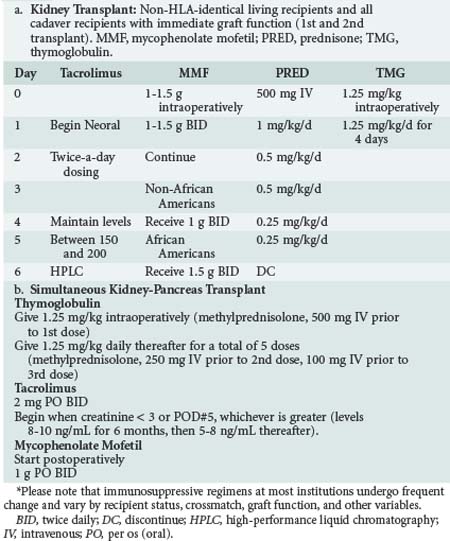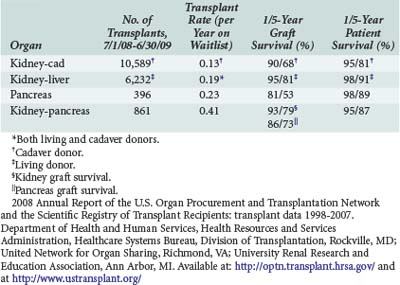196 Management of Patients after Kidney, Kidney-Pancreas, or Pancreas Transplantation
 Background
Background
Kidney Transplants
Kidneys are the most frequently transplanted organ; more than 285,000 transplants have been performed through 2007, with over 16,000 transplants performed per year in the United States1 (Table 196-1). Numerous causes of chronic renal failure result in the need for transplantation, the most common being diabetes mellitus and glomerular disorders (Box 196-1). The source of donors for renal transplantation are both cadavers and living donors. In 2009, there were 10,442 cadaveric donor transplants and 6387 living donor transplants performed.1,2 The living donor pool consists of both living related donors, who have a higher likelihood for a favorable crossmatch, and living unrelated donors. Recent surgical innovations such as using laparoscopy to obtain the donor kidney have decreased morbidity for donors and decreased costs.3 The living donor pool may be expanded through the use of programs to utilize nonrelated donors (e.g., kidney paired donations, non-directed donation).
Box 196-1
Common Indications for Kidney Transplant*
2008 Annual Report of the U.S. Organ Procurement and Transplantation Network and the Scientific Registry of Transplant Recipients: transplant data 1998-2007. Department of Health and Human Services, Health Resources and Services Administration, Healthcare Systems Bureau, Division of Transplantation, Rockville, MD; United Network for Organ Sharing, Richmond, VA; University Renal Research and Education Association, Ann Arbor, MI. Available at: http://optn.transplant.hrsa.gov/
Pancreas Transplants
Pancreas transplantation for control of diabetes was first successfully reported by Lillehei and colleagues in 1970.4 The major indication for transplantation of this organ is diabetes mellitus. Because of the significant morbidity associated with immunosuppression, transplantation of this organ in isolation is uncommon; most pancreatic transplants are carried out in conjunction with a simultaneous or previous kidney transplant. In 2009, there were 854 simultaneous kidney-pancreas transplants and 379 pancreas-after-kidney transplants or solitary pancreas transplants.2 Isolated pancreatic islet cell transplantation (autotransplantation) has been utilized as an adjunct to total pancreatectomy for patients with intractable pain due to chronic pancreatitis and is an active area of research using human and genetically modified animal islet cells to produce insulin while minimizing the risks of immunosuppression.5 However, these techniques are difficult to apply outside of specialized centers.
Compared with other solid-organ transplant operations, rejection is more difficult to diagnose in pancreas transplantation for a number of reasons. Hyperglycemia is not manifested until a significant portion of the graft is lost. For grafts drained into the bladder, decreases in urinary amylase concentrations sometimes suggest that rejection is occurring, although this test is not very sensitive. Needle core biopsies under ultrasound guidance using 18- or 20-gauge needles have reduced complications associated with biopsies to 2% to 3%.6 The problem of detecting rejection of pancreatic grafts has prompted efforts to carry out simultaneous pancreatic and kidney transplants, using the kidney as a “canary” to detect rejection of both organs. This indicator of rejection is not as effective in pancreas-after-kidney transplants, because the two organs are immunologically distinct, as evidenced by higher pancreas graft loss rates after pancreas-after-kidney procedures as compared with simultaneous transplants (22% versus 15%).7 The advantage of early identification of rejection must be balanced against the increased risk of perioperative complications as a consequence of the more challenging simultaneous operation.
 Ethical Issues
Ethical Issues
A number of ethical issues are related to transplantation. Unstated (and/or unintended) coercion to donate can be overwhelming for the family members or loved ones of a patient with renal failure. The physician must act as an advisor, not only for the recipient but also for potential donors. The risk of mortality for donors is low (0%-0.03%), but there is a complication rate of 18%.8 There is some evidence that renal donors are at slightly increased risk for late renal failure after donation.9,10 These issues mandate a frank and open discussion prior to donation.
 Current Immunosuppressive Agents/Regimens
Current Immunosuppressive Agents/Regimens
The field of immunosuppression has undergone many changes over the past decade, driven by a much better understanding of the immune system, allowing the development of targeted therapies. Most patients will receive a combination of agents to prevent rejection. These agents include calcineurin antagonists (cyclosporine, tacrolimus), proliferation signal inhibitors (sirolimus, rapamycin, or everolimus), proliferation inhibitors (azathioprine, mycophenolate mofetil), and corticosteroids. Other agents frequently used to combat rejection include antilymphocyte antibodies and interleukin (IL)-2 receptor antagonists. Induction therapy with anti-T-cell antibodies or IL-2 receptor antibodies are commonly utilized in pancreas transplantation. A summary of these agents and mechanisms of action is provided in Table 196-2.
TABLE 196-2 Immunosuppressive Agents and Mechanism of Action
| Class of Agent | Uses | Mechanism of Action |
|---|---|---|
| Corticosteroids (methylprednisolone, prednisone) | Induction, maintenance, rejection | Redistribution of lymphocytes Block T-cell proliferation, IL-2 synthesis |
| Antilymphocyte antibodies (antithymocyte globulin, OKT-3) | Induction, rejection | Lymphocyte depletion |
| Humanized antibodies (basiliximab, daclizumab) | Induction, rejection | Specific targets: IL-2 receptor |
| Calcineurin inhibitors (cyclosporine, tacrolimus) | Maintenance, rejection | Inhibit IL-2 production Inhibit expansion and differentiation of T cells |
| Proliferation signal inhibitors (sirolimus [rapamycin], everolimus) | Maintenance | Block cytokine-driven cell cycle progression |
| Antimetabolites/antiproliferative agents (azathioprine, mycophenolate mofetil) | Maintenance | Inhibit RNA/DNA synthesis |
IL-2, interleukin-2.
Most of the immunosuppressants have significant side effects and toxicities and significant drug interactions. For a complete discussion of this issue, please see Chapter 176. Common side effects of immunosuppressive agents are summarized in Table 196-3.
TABLE 196-3 Side Effects of Common Immunosuppressive Agents
| Antithymocyte globulin | Fever, leukopenia, thrombocytopenia, serum sickness |
| Azathioprine, mycophenolate mofetil | Leukopenia, thrombocytopenia, anemia, diarrhea, abdominal pain, hepatotoxicity, pancreatitis |
| Basiliximab, daclizumab | Hypersensitivity (anaphylaxis), fever |
| Corticosteroids | Hyperglycemia, osteoporosis, impaired wound healing, hypertension, Cushingoid facies, Addisonian crisis (from rapid withdrawal) |
| Cyclosporine | Nephrotoxicity, neurotoxicity, drug interactions, hypertension, hyperkalemia, hirsutism, gingival hyperplasia |
| Sirolimus, everolimus | Hyperlipidemia, myelosuppression, impaired wound healing, diarrhea, arthralgia, pneumonitis |
| Tacrolimus | Nephrotoxicity, neurotoxicity, drug interactions, hypertension, hyperkalemia, diarrhea, diabetes, tremor |
| OKT-3 | Pulmonary edema, fever, rigors, diarrhea, headache, bronchospasm, increased cytomegalovirus infection, risk of posttransplant lymphoproliferative disorder |
 Common Related Diseases and Conditions
Common Related Diseases and Conditions
The vast majority of patients receiving kidney and/or pancreas transplants do not require admission to the intensive care unit (ICU). For those patients who do require admission, most are admitted because of perioperative difficulties, which are frequently related to an underlying medical disorder (Box 196-2). A number of medical illnesses are more common in patients with chronic renal failure, including atherosclerotic heart disease, hypertension, congestive heart failure, diabetes mellitus, chronic obstructive pulmonary disease, peripheral vascular disease, and cerebrovascular disease. Discussions with the patient or family often will reveal a history of one or more of these illnesses, allowing evaluation and treatment to be tailored appropriately for the patient.
 Routine Perioperative Care: Kidney or Kidney/Pancreas Transplant
Routine Perioperative Care: Kidney or Kidney/Pancreas Transplant
For typical kidney transplant recipients without acute tubular necrosis, a brisk diuresis begins within minutes of revascularization of the kidney graft. This diuresis is due to a number of factors including intraoperative administration of diuretics, proximal tubular damage related to allograft ischemia, fluid and electrolyte disturbances as a result of chronic renal failure, and osmotic factors related to uremia. In patients after kidney-pancreas transplantation, the diuresis also can be related to hyperglycemia. Tight control of blood glucose concentration should be achieved using an insulin infusion. Many patients who were euglycemic before transplantation become hyperglycemic after transplantation, owing to the effects of corticosteroids (occasionally administered to prevent rejection) and the stress of surgery. The appropriate target for blood glucose control remains controversial, with recent evidence showing no benefit to tight glucose control.11 Nonetheless, in pancreas transplant patients in particular, insulin infusions around the time of transplant have been associated with improved islet function.12 Our current practice is to maintain blood glucose concentration at 80 to 140 mg/dL. An example of an insulin drip protocol is noted in Figure 196-1. Urinary losses should be corrected with a hypotonic solution; a common prescription is 2.5% dextrose in 0.2% saline infused at a rate of 1 mL per milliliter of urinary output for the first 12 to 24 hours after transplantation. Sodium bicarbonate and potassium chloride should be added as needed, based on frequent measurements of serum electrolyte concentrations. Urine volumes of less than 100 to 200 mL/h within the first 12 hours after renal transplant may represent a problem with the graft, and this finding should be immediately communicated to the transplant service (Box 196-3).
Immunosuppression is typically initiated in the operating room and continued postoperatively. At most transplant centers, the dosing of the immunosuppressive agents is protocol driven and determined by the transplant service. Examples of standard protocols for kidney transplant and simultaneous kidney-pancreas transplant patients are illustrated in Table 196-4.
TABLE 196-4 Examples of Immunosuppression Protocols for Kidney Transplant and Simultaneous Pancreas-Kidney Transplant in the Immediate Postoperative Period*

Several specific issues should be considered in pancreas transplantation aside from the usual management of kidney transplantation. The first of these is related to the high rate of graft loss in pancreas transplants owing to portal venous thrombosis. Many centers use a low-dose anticoagulation regimen of unfractionated heparin (100-500 units IV hourly as a continuous drip) in an effort to reduce graft loss from this complication. Systemic anticoagulation increases the risk of postoperative hemorrhage. Second, there is a high incidence of wound and intraabdominal infections after pancreas transplantation, being as great as 47% in some centers.13,14 Some centers advocate longer courses of broad-spectrum antibiotics because of concerns about infection, although data to support this practice are lacking.
 Posttransplant Complications
Posttransplant Complications
Posttransplant issues requiring ICU admission can be divided into those occurring immediately post transplant and those occurring at some time remote to the perioperative period. Kidney transplant patients are admitted to the ICU at a frequency of 16 per 1000 patient-years and have a mortality rate associated with admission of 40%, significantly higher than the general population.15 Common postoperative complications after kidney and/or pancreas transplantation are listed in Table 196-5.
TABLE 196-5 Common Postoperative Complications: Kidney, Kidney-Pancreas, Pancreas Transplant
| Early | Late |
|---|---|
| Myocardial infarction | Myocardial infarction |
| Renal failure | Renal failure |
| Hyperglycemia | Transplant artery stenosis |
| Graft thrombosis | Respiratory failure |
| Hemorrhage | Posttransplant infection (immune-compromised host) |
| Wound infection | |
| Respiratory failure | Posttransplant lymphoproliferative disorder |
| Posttransplant infection (hospital acquired) | Graft pancreatitis |
| Deep venous thrombosis | Acute and chronic rejection |
| Metabolic acidosis | |
| Graft pancreatitis | |
| Hyperacute and acute rejection | |
| Bladder leak | |
| Pseudomembranous colitis |
Respiratory Failure Distant To Transplant
Initial treatment for posttransplant respiratory failure distant to surgery requires broad-spectrum antibacterial, fungal, and viral therapy until a definitive diagnosis is reached. It is not unusual in such circumstances to have patients on agents that will cover common bacterial organisms, Candida and Aspergillus, and CMV (see also Chapter 195). Common regimens include broad-spectrum antibiotic agents with antipseudomonal and antianaerobic activity, an agent with gram-positive activity, a broad-spectrum antifungal agent, and ganciclovir to provide antiviral coverage for cytomegalovirus and other members of the herpesvirus family. Similarly to other work in the ICU care, delay to appropriate antibiotics in transplant patients has been associated with worsened outcomes.16 A number of appropriate agents for this purpose are listed in Table 196-6. In situations where Pseudomonas is strongly suspected, an additional agent should be added to provide double coverage of this organism. In situations where the patient has high risk for or has known vancomycin-resistant Enterococcus faecium, one of the new gram-positive agents should be chosen. Another key component of treatment in this setting is strong consideration for short-term discontinuation of most immunosuppressive medications. The practice at our institution is to hold all but maintenance doses of corticosteroids when infection is strongly suspected. It is frequently possible to tailor antimicrobial therapy as results return. For instance, in the setting of a patient with a low white blood cell count, diffuse pneumonitis, and positive screen for CMV, it is not unreasonable to discontinue antifungal therapy. It is important for the intensivist to be willing to revisit the diagnosis on at least a daily basis, especially if the clinical course is not consistent with the working diagnosis.
TABLE 196-6 Empirical Agents for Early Treatment of Infection in Kidney/Pancreas Transplant Patients
| Class of Agent | Agent | Dose* |
|---|---|---|
| Broad-spectrum antibiotic agents† | Piperacillin/tazobactam | 3.375 g IV q 6 h |
| Meropenem | 0.5-1 g IV q 8 h | |
| Imipenem/cilastatin | 0.5-1 g IV q 6-8 h | |
| Gram-positive agents‡ | Vancomycin | 1-1.5 g IV q 12-24 h |
| Daptomycin§ | 4-6 mg/kg IV daily | |
| Quinupristin/dalfopristin | 7.5 mg/kg IV q 8 h | |
| Linezolid | 600 mg IV q 12 h | |
| Tigecycline|| | 100 mg IV load, 50 mg IV q 12 h | |
| Antifungal agents | Voriconazole | 6 mg/kg IV q 12 h × 2, then 4 mg/kg IV q 12 h |
| Posaconazole | Oral only: 200 mg 3-4 times daily | |
| Caspofungin | 70 mg load, 50 mg IV daily | |
| Anidulafungin | 200 mg load, 100 mg IV daily | |
| Liposomal amphotericin B | 3-10 mg/kg IV daily | |
| Antiviral agents¶ | Ganciclovir | 2.5-5 mg/kg IV q 12 h |
| Foscarnet | 90 mg/kg IV q 12 h |
* Please note that doses given do not account for renal or hepatic insufficiency common in critically ill patients. Prior to choosing an empirical antibiotic regimen, the clinician should carefully consider the patient scenario and medication side effects related to the specific patient.
† Rather than a single agent, combination agents covering both gram-negative organisms and anaerobes may be chosen (e.g., fluoroquinolone plus clindamycin or metronidazole). For cases with a strong suspicion for Pseudomonas aeruginosa infection, additional Pseudomonas coverage should be added (e.g., fluoroquinolone or aminoglycoside).
‡ When vancomycin-resistant Enterococcus faecium infection is suspected, one of the latter 4 choices should be employed.
§ Daptomycin is not indicated for treatment of pneumonia (package insert).
|| Tigecycline is not indicated for treatment of hospital-acquired pneumonia (package insert).
¶ Antiviral agents directed toward herpesvirus family (most commonly CMV). Adjust for other viruses.

Full access? Get Clinical Tree






